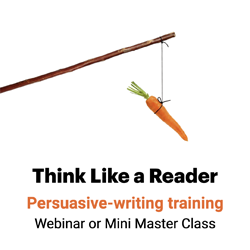Lead with the benefit, substantiate with the feature
I once reviewed an article for a company’s sales force with the headline:

Extraordinary customer experience: Be a customer advocate. Be Extraordinary
What followed was a reminder about the company’s guiding principles, an announcement of a new program, a bulleted list of tasks for participating in the program and a reference to a handout with all the rules.
Then, 228 words in, this oh-and-by-the-way aside:
Here’s the best part: Winners are treated to an amazing, all-expenses paid trip for two for four days in Las Vegas.
Here’s a simple tip for getting people to participate in your programs, buy your products and services and read more of your promotion:
Stop writing about your programs, products and services and promotions.
Start writing about what people can do with them.
If they might win a trip to Vegas, that’s your headline. That’s your lead.
It’s the easiest way to draw readers in and move them to act: Lead with the benefits. Substantiate with the features.
How to find the benefits
To lead with the benefits, first you have to find them. And that can be a tough, given that our assignments come to us in the form of features.
So start there.
1. Start with the features.
The feature is What it is. It’s an attribute of the product, service, program or idea.
Take Apple’s new MacBook Air. It includes a:
New Apple battery
Would you drop $1,100 and change for that thing? Me neither.
And that’s how people feel when they read about features in your pieces. Nobody’s looking for features. So you need to translate.
2. Translate into advantages.
The next thing you ask, is “Why is that feature important?” That will lead you to the advantages. If the feature is What it is, the advantage is What it does.
In the case of that MacBook Air, the advantage is:
It’s a long-lasting battery with a 12-hour charge.
One thing I’ve noticed by doing this a million times for my clients: When you get to the feature, you will have landed on a noun: battery.
When you get the advantage, you will have landed on a modifier — an adjective or adverb — like long-lasting and 12-hour.
I’m starting to get the picture, but it’s not long-lasting or 12-hour that readers and buyers are looking for. So you need to keep translating. The next thing you’ll translate into is the benefits.
3. Land on the benefit.
If the feature is What it is, and the advantage is What it does, the benefit is What it will do for you.
In the case of the MacBook Air, that benefit includes:
Taking a transatlantic flight? Line up the movies, because MacBook Air is ready to play for up to 13 hours — nonstop.
Now we’re talkin’.
Lead with the benefits.
Once you find your features, advantages and benefits, lead with the benefits and substantiate with the features. Features work at the end of a positioning statement, but don’t start your message with them. Sandwich the advantages between the features and benefits:
Play movies for up to 13 hours — nonstop — with our new long-lasting Apple battery.
[Benefit] Play movies for up to 13 hours — nonstop — with our [Advantages] new, long-lasting [Feature] Apple Battery.

Leave a Reply